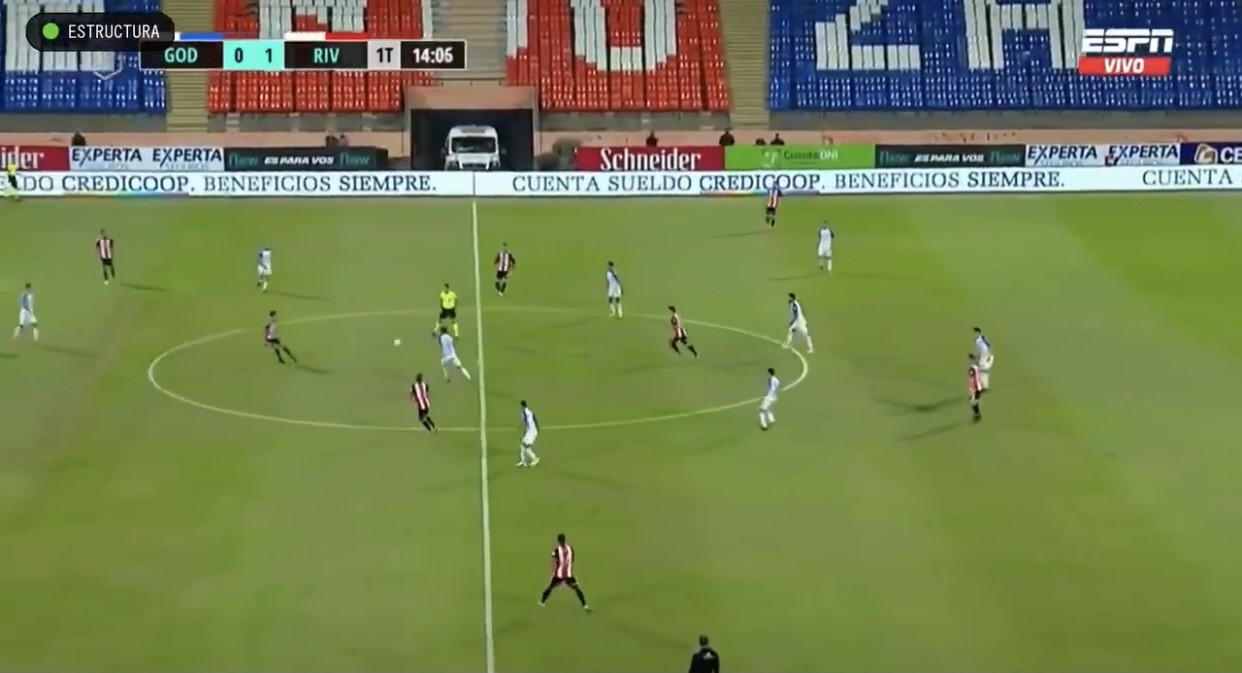Team Analysis: Marcelo Gallardo’s River Plate
Marcelo Gallardo has been setting waves in Argentina with his River Plate side
This June marks seven years since Marcelo Gallardo was appointed manager of River Plate. With 1 Copa Sudamericana, 3 Recopa Sudamericanas, 2 Copa Libertadores, 1 Suruga Bank championship, 3 Copa Argentinas, and 3 Supercopa Argentinas, he is the most successful coach in the club’s history. He has been linked with several clubs in Europe over the past few years, most notably Barcelona.
Gallardo’s River Plate are a possession-orientated side. The formation he’s most commonly associated with is the 4-1-3-2, though he’s also used a 4-3-3, and 3-5-2. He is not the man of one formation only, changing it on a game-to-game basis while at the same time maintaining his principles.
BUILD-UP:
River usually use a 3+1 build up shape. If using a 4 man backline Perez will drop in between the CBs, but will stay ahead if they are using 3 at the back. He helps with circulating possession at the back though doesn’t take much responsibility in progressing the ball.
3+1 build-up shape
River mainly progress the ball through the wings and the wide CBs, Javier Pinola and Paulo Diaz play a big role. With 3 CBs/2CBs+DM in their first line, the FBs Montiel and Angileri/Casco are allowed to move higher. They hug the touchline, making the pitch as big as possible while the wide midfielders Nicolas De La Cruz and Nacho Fernandez (recently departed) occupied the half-spaces. The strike duo of the traditional 9, Rafael Santos Borre, and the more technically adept Matias Suarez pin the defensive line back, threatening to make dangerous runs in behind.
If the opportunity presents itself, River don’t hesitate to go direct to the forwards who make runs into the channels.
Against more settled opposition, the wide CBs Javier Pinola and Paulo Diaz carry a lot of responsibility in the build-up. Gallardo uses them as ball carriers and encourages both to dribble with the ball into midfield. This either opens up passing angles or attracts a player, liberating a teammate of their marker.
In this image, you can see very well how this dribbling has attracted a player. In this case, the FB decides to close down Angileri leaving Carrascal free to receive in the half-space.
The wide midfielders are arguably the most important players in the system which is probably why even though Gallardo tends to change formation, he usually uses one with a midfield 3 at least, so they can be used on both sides while still having a presence in the middle. They help to progress the ball through fluid positional rotations, offer passing options inside for the FBs, form overloads and are involved in chance creation and finishing.
As mentioned, River prefer to progress the ball on the flanks. Sometimes to facilitate this, the wide midfielder and the FB rotate. This acts as a form of dismarking and opens up passing lanes making it easier to receive.
Here De La Cruz and Casco Rotate allowing the former to receive the ball in space
River plate mainly uses these rotations on the side where De La Cruz operates, maybe due to his dribbling ability. These situations allow him to make use this qualitative superiority 1v1 against the FB.
Another common pattern: when the FB/WB receives, the wide midfielder runs down the wing. While they do so they drag a marker with them opening up the passing lane to one of the forwards who have dropped deep.
The striker is then encouraged to play first time to the midfielder who’s carried on his run. They mainly create chances through the wide areas through either cutbacks or crosses.
The narrow positioning of River’s attackers allows for two things: space on the flanks so the FBs are able to pick out a good cross, as well as to have numbers in the box for when the cross comes in.
When the ball is switched to the far side, the opposite FB is drawn in and a River midfielder underlaps in the vacated space to get into cutback positions.
OFFENSIVE SHAPE:
In attack, their offensive shape resembles a 3-2-5/3-1-1-5.
When progressing the ball through the middle, they overload the centre, which is maybe another reason why Gallardo loves the 4-1-3-2.
River plate set up a 3v2 in the midfield
River plate set up a 4v3 in the centre.
PRESSING:
Borre and Suarez lead the press looking to cover the central corridor. When the ball is forced wide, the wide midfielders shuffle across. They aim to get the ball to the flank and then squeeze the space, ideally getting numerical superiority in the area. If they are able to force a turnover they aim to transition quickly into attack. Perez can stay deeper and deal with any balls that are played long.
Option-oriented press:
CONCLUSION:
A talented young tactician, Gallardo has had an incredibly successful stint at River Plate, building a dynasty in Argentina despite losing key players over the years (most recently Palacios to Leverkusen and Martinez Quarta to Fiorentina). A move to Europe could soon be on the cards for the Argentine
Written by Osman who you can find on Twitter with the @O_H_99

















